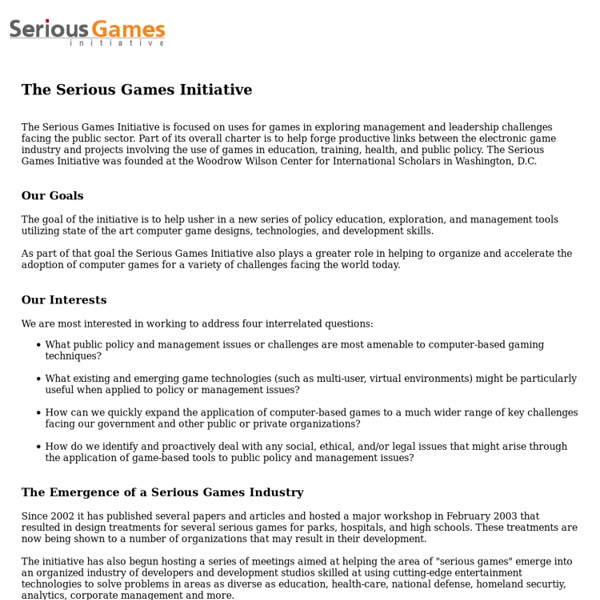



Game based learning & Gamification Lots people want to get started with game based learning, gamification and serious games in their training. We’ve been curating game related content for over a year and a half while conducting our own research and case studies. Here are 100 articles related to games and learning. Some of them are research-based, while others just offer an interesting perspective to spark discussion. Take what you need and share this with a colleague. XEODesign Our Story XEODesign (pronounced zee-oh-design) is an award-winning firm that helps organizations increase engagement with play. We identify ways to increase engagement by eliminating factors that prevent play, and we uncover new opportunities for creating experiences based on what players like the most about games. We envision new game-inspired products and services, and we design the player behaviors, game mechanics, and emotions that make them work best.
The nine golden rules of using games in the language classroom I think you might want to download these activities so you can use them later… so here’s a handy PDF file of this blog post! I’ve long been an admirer of the use of games in teaching. Indeed, one of my most popular posts ever here on the Teach them English blog is the rather misleadingly titled ‘Why I don’t use games in the language classroom’ which, if you’ve got a spare ten minutes, gives you as good a background into the role of games in the language classroom as you’ll ever need (no need for me to be modest!). Games remain a fundamental part of my teaching as they can be used to liven up lessons, while also creating a relaxed learning atmosphere where learners feel confident to practice new language skills. The importance of games cannot be understated in the role they play in providing alternative ways of learning or showing that you can recall what has been learned. 1.
Badges What is a Badge? badge [baj]: a special or distinctive mark, token, or device worn as a sign of allegiance, membership, authority, achievement, etc. (Source: Dictionary.com) Game-Based Learning Units for the Everyday Teacher Game-based learning (GBL) is getting a lot press. It is an innovative practice that is working to engage kids in learning important 21st century skills and content. Dr. Judy Willis in a previous post wrote about the neurological benefits and rationale around using games for learning.
A Checklist for Evaluating Gamification Platforms Conventional wisdom has it that sales people love competition. They want a challenge, beat their friends and colleagues, and be on top of the leaderboard. And sales managers constantly use carrots and competition, because this is what “motivates" sales agents. But is this true? We know that sales reps have to make money for the company. Depending on the product or service sold, the sales process and effort can vary significantly, from products and services which need a lot of explaining and have long sales cycles, to others that need nearly no explanations and sell quickly. Submrge Garry’s Mod A physics-based “sandbox” in which users can do almost anything, with a wide selection of assets (3D models, sounds, actions). Read More Spaceteam
Gamification Platform Matrix Conventional wisdom has it that sales people love competition. They want a challenge, beat their friends and colleagues, and be on top of the leaderboard. And sales managers constantly use carrots and competition, because this is what “motivates" sales agents. But is this true? We know that sales reps have to make money for the company. Alice.org Alice is an innovative 3D programming environment that makes it easy to create an animation for telling a story, playing an interactive game, or a video to share on the web. Alice is a freely available teaching tool designed to be a student's first exposure to object-oriented programming. It allows students to learn fundamental programming concepts in the context of creating animated movies and simple video games. In Alice, 3-D objects (e.g., people, animals, and vehicles) populate a virtual world and students create a program to animate the objects. In Alice's interactive interface, students drag and drop graphic tiles to create a program, where the instructions correspond to standard statements in a production oriented programming language, such as Java, C++, and C#. Alice allows students to immediately see how their animation programs run, enabling them to easily understand the relationship between the programming statements and the behavior of objects in their animation.
Millennial Moms: Good Gaming at Home Bio Samantha Skey Samantha Skey works with top consumer internet companies to build scalable business models amid rapid growth. As Chief Revenue Officer for Recyclebank, a New York City-based clean web company, Skey built the company’s advertising and rewards strategy to serve thousands of brands. Create your own Interactive Fiction What is Interactive Fiction? Interactive Fiction (formerly referred to as Text Adventures) are a cross between reading a book and playing a game, where you control the main character. Rather than reading the story from start to finish, you interact with everything by typing commands at a prompt, discovering things as you go along. Well written games give you, the player, the impression that anything you type is understood by giving a sensible and meaningful response. Indeed, part of the fun of playing interactive fiction games is discovering responses to things you didn't expect to have been catered for.